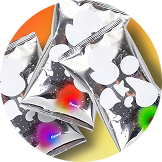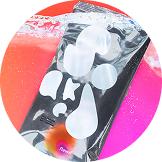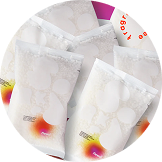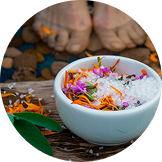Restless leg syndrome (RLS) can take a toll on your sleep quality, ability to focus, and of course, your sanity. That tingling, crawling, burning, or pulling sensation is enough to drive anyone crazy.
The good news is it’s far more prevalent than you may have realized, which means there’s an abundance of resources at your disposal to manage RLS. We’ll show you how to help restless leg syndrome below after explaining what it is and what causes it.
One of the best ways to get rid of restless legs is using a magnesium bath soak from Flewd Stresscare. We’ve created a variety of formulations using the most bioavailable magnesium chloride paired with other stress-busting nutrients to create a sense of calm in the body.
We only use 100% natural, active vitamins and minerals, and have earned the trust of over 100,000 happy customers and counting who rely on our soaks as part of their regular self-care ritual. Order yours today and find out what Flewd Stresscare can do for you!
“I absolutely love this bath soak and all the others I purchased. Leaves my skin soft and I have less leg cramps since using these.” - Sandee
“I really love this soak, it eliminates the aches and pains in my ankles and legs.” - Rick
“Pain soak was absolutely wonderful! I felt so good and without the usual pain and discomfort I normally feel with my fibromyalgia! (I tend to overdo with my activities and responsibilities that I get intense neuro/muscular pain and spasms, so I decided to try the Pain Soak) I intend to purchase more.” - Sharon
What is Restless Leg Syndrome (RLS)?
First things first, let’s figure out if what you’re dealing with is actually RLS. This is a neurological condition that causes an uncontrollable urge to move your legs, usually because something feels off with them.
It shows up most when you’re winding down, relaxing, or trying to sleep, which is exactly when you don’t want your legs staging a rebellion. We’ll start by unpacking symptoms and causes.
Symptoms of RLS
Most people describe the sensation as a deep itch, a crawl under the skin, or a buzzing that won't stop. It’s not usually painful, but it is maddening - especially when you’re exhausted physically and mentally, but your legs want movement.
Symptoms usually flare up in the evening and get worse the longer you're still. Relief only comes with movement, which makes it hard to sit through a movie, a flight, or even fall asleep.
Causes of RLS
We don’t yet know the exact cause of RLS. That said, experts believe it to be a mix of factors. Low iron levels in the brain, dopamine imbalance, and nerve dysfunction are all linked.
Sometimes it runs in families (especially if symptoms start before age 40), and other times it’s tied to other health conditions like kidney disease, diabetes, or pregnancy. Lifestyle habits can play a role too: poor sleep, lack of movement, or caffeine overload might make things worse.
RLS doesn’t discriminate, but it’s most common in adults over 40, especially women. Pregnant women (particularly during the third trimester) report this condition in really high rates, but it tends to disappear after delivery.
It’s been said that least 10% of people will deal with this frustrating ailment to some degree - and we have a feeling you fit the statistic if you’re here hoping to learn how to help restless leg syndrome. So, let’s get into our top tips on how to get rid of restless legs!
How to Help Restless Leg Syndrome at Home
You don’t have to deal with that constant twitchy, jittery feeling anymore. There are some tried and true methods for getting your body back into “relax” mode, so you can then get back to living life to the fullest.
It’s nothing crazy, either. Lifestyle changes and nightly rituals often make a bigger difference than you’d expect. One of the most effective pieces of advice we have to share on how to help restless leg syndrome is incorporating regular magnesium soaks.
Try a Magnesium Soak to Soothe Your Legs
There’s a strong link between low magnesium levels and restless legs. In fact, this mineral plays a role in over 300 bodily functions. It’s no surprise your legs go a little haywire when you’re deficient!
Magnesium helps muscles relax by regulating calcium in your cells and calming overactive nerve signals. Unfortunately, most people are magnesium deficient because it’s not the most bioavailable mineral when taken orally. So even if you have a magnesium supplement, it may not be doing you much good.
Worse, most oral supplements are tough on the gut, leading to those frustrating side effects like diarrhea. We talk about this in our comparisons of magnesium carbonate vs citrate and magnesium taurate vs glycinate.
Magnesium chloride is your best bet, but topical magnesium chloride is even better. Soaking in magnesium gets this vital mineral into the bloodstream throughout the entire body, so you can experience whole body relief fast - without the digestive discomfort!
Our epsom salt substitute is the perfect choice if you want to learn how to help restless leg syndrome through magnesium soaks. We combine ultra-bioavailable magnesium chloride hexahydrate with a blend of supportive vitamins, minerals, and essential oils.
What you won’t find in the formulation is any nasty stuff. No fillers, parabens, toxins, or fluff. Just 245g of stress-fighting nutrients in each pouch. Plus, they’re so easy to use - find the right soak to put RLS in the past below!
Which Flewd Stresscare Formula is Right For You?
All of our soaks have the potential to help with RLS since they contain bioavailable magnesium, but you can get more specific about the support you want by choosing a formula below:
- Ache Erasing Soak: Packed with magnesium, Vitamins C & D, and Omega-3s to ease deep muscle tension and physical stress. This is your best bet if your restless legs come with tight calves, aching hips, or neck tension that never quite lets go. The scent is bright and citrusy.
- Anxiety Destroying Soak: This formula includes magnesium, a full complex of B vitamins, and zinc to help calm your nervous system and regulate mood. Try this one if your legs get worse when your mind races or your heart pounds. It smells like the ocean with lime zest and soft white florals.
- Insomnia Ending Soak: Perfect for those whose RLS flares up at night. You get magnesium, Vitamins A & E, and L-Carnitine to support your body’s natural sleep signals. Say goodbye to that frustrating tired-but-wired feeling! The scent is sparkling Yuzu.
Incorporating these soaks into your self-care ritual is easy. Tear open the pouch and pour the entire thing into a full tub of warm water. Soak for at least 15 minutes (or longer if you’d like). You can rinse off after, but it’s not necessary.
Use the soak at least 3 times a week for best results. And if you don’t have a bathtub, you can try a magnesium foot soak instead! Order your stress relief bath soak and feel relief fast.
Stretch and Move Before Bed
It might seem backward - moving to stop movement - but light activity actually makes a massive difference. RLs tends to flare when you’ve been still too long, especially if your muscles are already tight or underused.
Try a quick walk around the block after dinner, or add 5-10 minutes of easy stretching before bed. Focus on your calves, hamstrings, and lower back - anywhere your body tends to hold onto tension. Even ankle rolls or gentle squats can help release that twitchy buildup so your legs aren’t begging for movement once you hit the sheets.
Other Ways to Support Your Sleep Routine
RLS and poor sleep go hand in hand. And while your soak is doing its job easing the physical side, your environment plays a big role in whether your brain follows suit.
Simply winding down with a nice Insomnia Ending Soak 30-60 minutes before bed is a good start. Light candles and turn the lights off, and read a book or practice mindfulness while you soak.
In general, you should keep screens out of the bedroom (or at least off 30 minutes before you try to sleep). Cool, quiet, and dark is the goal for the environment in your sleep sanctuary. Aim for 7-9 hours nightly.
Cut Back on Triggers That Worsen RLS
It sounds obvious, but it has to be mentioned in a conversation on how to help restless leg syndrome. Start noting the things that cause your symptoms to worsen, and then eliminate them from your life altogether.
Caffeine is a big one. It sticks around in your system longer than most people think. Try cutting off coffee and energy drinks after 2 PM. Alcohol and nicotine can also mess with your nervous system and disrupt sleep patterns.
You may suspect that your diet or meds are playing a role. It’s not all that farfetched. Track when your symptoms show up so you can connect the dots and adjust without guesswork.
Cool or Warm Compresses
One final piece of advice on how to help restless leg syndrome at home is to try alternating cool/warm compresses. Warmth helps increase blood flow and relax tight muscles, while cold can numb the uncomfortable sensations and calm nerve activity.
Try a a warm compress on your calves if they feel tight or achy. Or, go with a cool pack if the sensation feels more like buzzing or burning. You can even alternate between the two. Just keep the temperature comfortable and wrap compresses in a cloth to avoid skin irritation.
Supplements and Nutrients That May Help RLS
Remember, restless legs can sometimes be traced back to a handful of missing or imbalanced nutrients. We already talked about magnesium, so we’ll skip that one. Here are a few other supplements/nutrients you might be deficient in:
- Iron: Many people with RLS also have low brain iron levels, even if bloodwork looks “normal.” Iron helps regulate dopamine, the neurotransmitter tied to movement and muscle control.
- Folate and B Vitamins: B12 and folate support healthy nerve function. A deficiency in either can lead to nerve misfiring, which might show up as RLS. Eat eggs, fish, leafy greens, and fortified grains to get both of these.
- Zinc: This nutrient helps your body make neurotransmitters and supports muscle recovery. It’s not usually the first nutrient people think of for RLS, but it can help round out the stress response system and calm those legs down. That’s why we paired it with magnesium and B vitamins in our Anxiety Destroying Soak.
As always, it’s best to test before you supplement. Overdoing iron or zinc can backfire. Get your bloodwork done to confirm deficiency, then come up with a strategy to address it.
When to See a Doctor About Restless Legs
We hope this guide on how to help restless leg syndrome is all it takes to put this pesky problem in the past. If not, though, it’s time to loop in a professional. Don’t let the condition linger any longer than necessary.
A doctor can help rule out underlying causes like iron-deficiency anemia, kidney problems, or nerve issues. They can also review your medications as some allergy meds, antidepressants, and even antihistamines can make RLS worse without you realizing it. You should also check in with your provider if:
- Your legs feel painful (not just uncomfortable)
- Your symptoms affect other parts of your body (like arms)
- You’re pregnant and your symptoms are affecting your sleep or daily life
- You’ve tried lifestyle changes with zero relief
A little investigation and a personalized plan can make a huge difference in how your body feels every night. So, take the next step towards relief at Flewd Stresscare today!
Final Words on How to Get Rid of Restless Legs
That does it for our guide on how to help restless leg syndrome. As frustrating as this ailment is, it doesn’t have to dictate your life any longer.
Whether it’s a lack of magnesium, overfiring nerves, or just a system stuck in stress mode, there are ways to calm the chaos. From daily habits to bedtime rituals (and yes, a really good soak) can quiet the twitch and finally get the sleep your body’s been begging for.
Our blog has additional resources on topics like magnesium chloride vs glycinate and ashwagandha vs magnesium if you want to learn more about the magic of magnesium. But at this point, it’s time to feel the difference it can make in your life firsthand.
Your legs are restless. You’re exhausted. Drop a soak in the tub and let it handle the rest!
























































